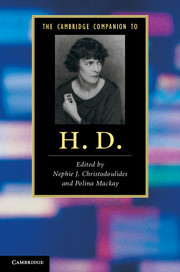Book contents
- Frontmatter
- Introduction
- PART I CONTEXTS AND ISSUES
- 1 ‘Uncanonically seated’: H.D. and literary canons
- 2 Facts and fictions
- 3 H.D. and the ‘little magazines’
- 4 H.D.'s modernism
- 5 H.D. and gender: queering the reading
- 6 Reading H.D.: influence and legacy
- PART II WORKS
- Further reading
- Index
- Cambridge Companions to…
4 - H.D.'s modernism
from PART I - CONTEXTS AND ISSUES
Published online by Cambridge University Press: 28 November 2011
- Frontmatter
- Introduction
- PART I CONTEXTS AND ISSUES
- 1 ‘Uncanonically seated’: H.D. and literary canons
- 2 Facts and fictions
- 3 H.D. and the ‘little magazines’
- 4 H.D.'s modernism
- 5 H.D. and gender: queering the reading
- 6 Reading H.D.: influence and legacy
- PART II WORKS
- Further reading
- Index
- Cambridge Companions to…
Summary
It is very hard to detach H.D.'s name from literary modernism. Indeed, her oeuvre demonstrates the fundamental themes, poetics and ideological standpoints of that movement: the change from Victorian norms to a modern world primarily concerned with science, technology and the nature of modernity itself; the coinage of innovative poetics; and the challenging of existing stereotypes through new discourses, in H.D.'s case through the ideology of early to mid twentieth-century feminism.
Indeed, H.D.'s relationship with modernism has been explored at great length. Among the most sophisticated analyses is Cassandra Laity's reading of H.D. in light of Romantic and Victorian literary values. Laity argues that the poet embraces the sexuality-driven poetic masks of hermaphrodism, androgeneity and homoeroticism previously propagated by decadent Romantics such as A.C. Swinburne and Walter Pater, and suggests that H.D. appropriates these personae to ‘fashion a modernist poetic of female desire’. Georgina Taylor's subsequent study, H.D. and the Public Sphere of Modernist Women Writers (2001), demonstrates the author's centrality in the modernist public sphere of literary women. With other female authors – among them, Amy Lowell, Edith Wyatt and Marianne Moore – H.D. had a hand in promoting modernist work primarily through the editorship of self-published magazines such as The Egoist, Little Review and Poetry. Both Laity and Taylor see H.D.'s work through the lens of identity politics, whereby aesthetics and poetic masks speak for communities of women. More recently, Adalaide Kirby Morris attempts to explore H.D. outside the field of gender studies.
- Type
- Chapter
- Information
- The Cambridge Companion to H. D. , pp. 51 - 62Publisher: Cambridge University PressPrint publication year: 2011
- 1
- Cited by



